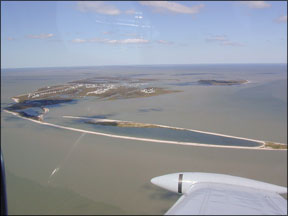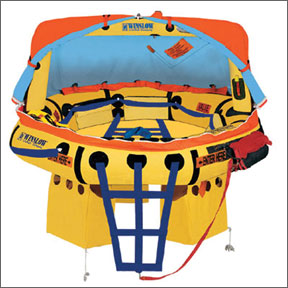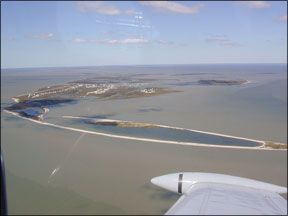There we were in a friends F33A Bonanza at 9000 feet in radio darkness from Houston, Jacksonville, and Miami Centers. That put us plus or minus six feet from the geographical center of the Gulf of Mexico. We were droning along under a full moon at about 10 pm, listening to Jimmy Buffett on the CD player. The in-cockpit conversation mainly focused on debating which Key West bar we were going to grace as soon as we landed.

288
Then the radio came to life and ruined the mood. “Baron 12345, this is American 3743, are you on the frequency?”
My friend paused, then answered, “Uh, yep; were IFR to KEWY, niner thousand with Buffett on the CD player, 345.”
“Okay; Miami asked us to see if you were on the radio. Theyre expecting you to check in.”
“Yeah, we cant get em yet-too low,” he explained and gave a position report and ETA for the fix where we would report in before adding, “By the way, were a Bonanza.”
Long pause.
Then came one more question from FL310, “345, youre a B-o-n-a-n-z-a ? Out here?”
We looked at each other quizzically. The engine doesnt know its over water. The airframe doesnt know its over water. Weve sailed across the Gulf a dozen times and there are no drug runners or pirates to shoot at us at 9000 feet.
“Flying over the Gulf isnt dangerous,” we thought.
And its not more or less dangerous, per se, than simply orbiting ones home plate for the same amount of time. But flying over water and out of gliding distance from land does mean if something happens, the challenges well face on emerging from our cozy airplane cabin will be different than the green, green grass of home. The same is true when operating over snow-covered mountains in winter or the rural southwest in summer.
No Difference?
Ive had a dozen more birthdays since that mind-numbing trip to Key West. Ive become friends with Doug Ritter, one of the foremost authorities in being Equipped to Survive (www.equipped.org). Ive tried to pay more attention.
It costs me 20 minutes extra on a 3+45 flight to go through Cross City, staying over land on my way to Key West. Thats how I do it now in a single. Might do it that way in a twin, too. But Key West is an island and sooner or later youre going to cross some water.
So, how do we mitigate the risks of flying over dangerous terrain or water? Not counting all of the wise things we should do in the form of pre-flighting, what should we do for the unexpected post flight if we have to put it down where we didnt plan to put it down. Is there really any difference in the risks of flying over water, a desert, the mountains or the pine trees? After thinking about this for a long time, Ive come to the conclusion there really isnt much difference. Lets look at why.
Footwear
Never wear anything in the airplane that youre not willing to be wearing if you have to walk/swim out. For overwater flights, that would be top-siders. I can kick those off easily to swim. For mountainous terrain, it would be heavy hiking boots. To cross the pine trees in the South, it would be, at the very least, good walking shoes or light hiking boots.
If you think wearing hiking boots in the cockpit is uncomfortable or inconvenient, try walking out of rough or swampy terrain in a pair of loafers.
Emergency Supplies
Nothing in the airplane is available to you unless you can reach it from your seated

288
position. Sleeping bags in the baggage compartment are camping supplies, not part of your emergency equipment. The same goes for a raft, or a medical kit, or that nice, new PLB you got for Christmas. If you cant reach it, consider it unavailable in an emergency.
You may survive the crash and not be able to move. For this reason, a geeky, pocketed vest is not a bad concept. Get the things you need where you can reach them if you need them. If you have back seat passengers, they can reach a larger area than you can, but get the items you might need within your reach before you touch down.
Rafts or Tents
There are all levels of quality of rafts available, and some that might be acceptable in warm water will only prolong your death in cold water. The good ones are expensive, but what would you pay for one when you find yourself treading water in the middle of nowhere?
Another great use for a raft for those who seldom fly over water, but do fly over mountains, is use as a shelter. A raft does great double duty. It can keep you out of the snow, rain or sun. A tent isnt of much use when youre treading water, but a raft can work as a tent. Doug Ritters demonstration in a swimming pool about how difficult it is to get into a raft is an eye-opener. The more expensive rafts have ladders. What would you pay for a ladder if youre in the water and cant get into your bargain raft? For a North Atlantic crossing, you will definitely want to wear a survival suit.
Water
Many pilots carry water over the desert. The weight would be worth it if you made a nice, smooth touchdown and had to walk out. It would be good to have in the middle of the Gulf, too. The savvy pilots carry this water in plastic containers that can be filled or emptied based on the need for the flight. The empty container weight is negligible when you dont need the water but it is easy to fill when you are preparing for a flight where it would be a good idea.
Medical kits
There are a number of very good medical/emergency kits available and if youre so inclined you can make your own less expensively. Sportys (www.sportys.com), Equipped to Survive, and Brent Blues Aeromedix.com (www.aeromedix.com) have kits ranging from minimal to comprehensive. Being in the healthcare field for 30 years, I decided on the big kit from Aeromedix.
Ive opened Doc Blues Emergency Medical Kit on several occasions that werent emergencies and have found it very useful to have onboard. Of all of my goodies, that kit has been the most useful. Doug Ritters smaller kit is a reasonable choice. You can even build your own…but get one in the airplane.
Survival/Protection
When flying over Alaska or the remote areas of Canada, Ive taken an appropriate firearm. You might have to eat or keep that Grizzly away. I take a 12-gauge shotgun with birdshot, buckshot and slugs.
There are those who might suggest that if you fly over large metropolitan areas you should take a handgun. Regardless, if you add a handgun to your gear, be sure its caliber starts with a “4” and make yourself aware of the local, state or federal laws apply to carrying firearms. There is no better source of this information than fellow pilot and outdoorsman Tom Greshams GunTalk (www.guntalk.com).
What To Take?
You can have enough survival gear so as not to be able to take the Aflac duck with you without being over gross. For certain flights, flares, saws, folding shovels, etc., all come to mind as items that could be of use. But are they worth the weight?
Only you can decide that. Taking everything you might need is obviously not reasonable for most, but being prepared with the items that are appropriate for your survival in and around the terrain you frequently traverse should always be present in your airplane. I have a supplementary kit I can add in a flash to the things that are always with me, which includes things that would be good to have when crossing the more inhospitable areas. That way I make it easy-otherwise, I might not slow down my Type A self long enough to get it all ready before the trip that materializes on short notice.




